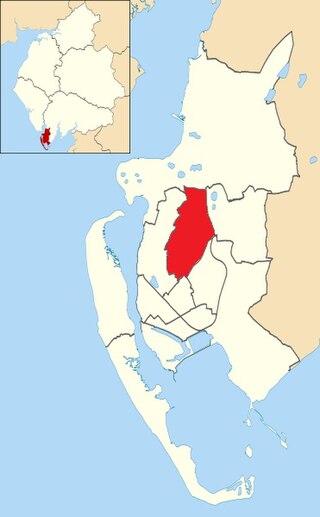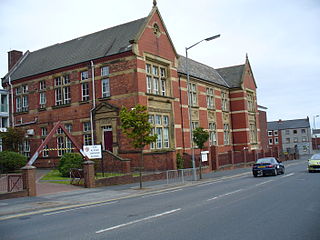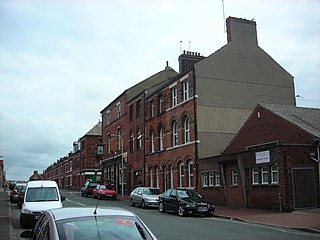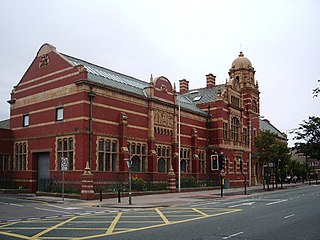
Roose or Roosecote is a suburb and former ward of Barrow-in-Furness, Cumbria, England. The word 'roose' is Celtic for "moor" or "heath" and the suffix 'cote' of Roosecote means "hut" or "huts". Before the building of Roose Cottages and the arrival of the Cornish miners Roose was pronounced with a hard S, as in goose; now it is locally pronounced 'Rooze', due to the Cornish accent. Roose is served by Roose railway station, one of the few remaining stations on the Furness Line in the Barrow area.

Sol Northampton is a leisure complex in Northampton, England, with a multi-screen cinema, gym and beauty salon among other facilities. It was constructed in 2002 to replace the Barclaycard head office building previously sited there from the 1970s before relocating to the nearby Brackmills industrial estate.
Safari Cinema was an entertainment venue at 225 London Road in Broad Green, Croydon. It was opened in 1936, and closed in 2004. The building was demolished in 2005, and was described at the time as "the last of the historic cinemas from the Golden Age left in Croydon".

Hawcoat is an area and former electoral ward of Barrow-in-Furness, Cumbria, England. Historically part of Lancashire, it is one of Barrow's most northerly wards and is bordered by Roose, Newbarns, Parkside, Ormsgill and the town of Dalton-in-Furness to the north.

The Higher Grade School building in Barrow-in-Furness, Cumbria, England is Grade II listed and has functioned as a number of educational institutions throughout its long history. From completion until 1930 the building was occupied by the Barrow Higher Grade School.

Hindpool is an area and electoral ward of Barrow-in-Furness, Cumbria, England. It is bordered by Barrow Island, Central Barrow, Ormsgill, Parkside and the Walney Channel, the local population stood at 5,851 in 2011. The ward covers the entire western half of the town centre and includes Barrow's main shopping district. Other local landmarks include the Furness College Channelside campus, the Dock Museum and the Main Public Library. Hindpool is also home to two stadia - Barrow Raiders' Craven Park and Barrow A.F.C.'s Holker Street.

Abbey Road is the principal north to south arterial road through Barrow-in-Furness, Cumbria, England.

Emlyn Hughes House is a landmark four-story office building located at the intersection of Abbey Road and Holker Street in Barrow-in-Furness, England. It is named after local footballer Emlyn Hughes who captained both Liverpool F.C. and the England national team, a statue of Hughes is also located outside of the building. Emlyn Hughes House replaces the Art Deco Ritz Cinema and was designed by Bowker Sadler architects and built by Capita Symonds for Barrow Borough Council. There was much speculation that the development would become a 'white elephant' because a year after completion in 2008 the whole building remained vacant.

Barrow-in-Furness Main Public Library is a Grade II listed Beaux-Arts style building located at Ramsden Square, Barrow-in-Furness, England. Operated since 2023 by Westmorland and Furness Council, it is the largest library in the town and the present structure, designed by J A Charles was originally built as a Carnegie library with support from the Carnegie Foundation.

The Hindpool Retail Parks are a set of four conjoined retail parks in the Hindpool area of Barrow-in-Furness, England, United Kingdom. Some thirty stores and leisure facilities contain a total of 43,000 m2 (460,000 sq ft) of retail space. The four retail parks are Cornerhouse Retail Park, Cornmill Crossing, Hindpool Retail Park and Hollywood Park. The largest and only other retail park in Barrow is Walney Road Retail Park - Asda, Argos, Home Bargains, Matalan, Starbucks and Stollers.
Barrow Park is a 45-acre public park in Barrow-in-Furness, Cumbria, England. It is located entirely within the Parkside ward, to which the park lends its name, bound by Abbey Road, Park Drive, Greengate Street and Park Avenue. Barrow Park was designed by Thomas Mawson in 1908 and was constructed in stages over the following two decades. Originally sited on the outskirts of Barrow, the park is now more or less central due to rapid growth of the town northwards during the early 20th century. It is designated by Historic England as Grade II on the Register of Historic Parks and Gardens.

The Nan Tait Centre is a Grade II listed building located at Abbey Road in the Hindpool area of Barrow-in-Furness, Cumbria, England.

The Furness Abbey Hotel was demolished in 1953, having been bombed in May 1941. Its site now forms the car park to Furness Abbey and the museum. The station at Furness Abbey also suffered bomb damage and was demolished in the early 1950s. The original station booking office and refreshment room, built in 1862, which had been attached to the hotel, survives as The Abbey Tavern, standing in Abbey Approach, Barrow-in-Furness, Cumbria, England, to the north of the remains of Furness Abbey. The current structure is recorded in the National Heritage List for England as a designated Grade II listed building.

The John Whinnerah Institute is a Grade II listed Art Deco building and former educational establishment located on Abbey Road in Barrow-in-Furness, England. Having been constructed between 1937 and 1938 on the site of the demolished Jute Works it is the newest listed structure in the town, despite this it was drastically altered in 2004 when the entire interior was demolished to accommodate new retail units leaving only the Abbey Road and Hindpool Road facades.

The Barrow Jute Works was a jute and flax mill located in Barrow-in-Furness, Lancashire, England during the late 19th and early 20th centuries. The mill was built for the Barrow and Calcutta Jute Company which was founded by James Ramsden in 1870 in an attempt to diversify Barrow's economy which was heavily focused on iron and steel production. The Jute Works itself was designed by architects Paley and Austin and occupied over 12-acres with a 580 feet (177 m) facade on Hindpool Road and 360 feet (110 m) along Abbey Road. The mill was served by its own railway station on a branch of the Furness Railway which connected it to the town's docks, steelworks and cornmill.

Furness Abbey railway station was located in the Barrow-in-Furness area of the Furness Peninsula, England. It opened in 1846, closed in 1950 and was subsequently demolished.

The Custom House in Barrow-in-Furness, Cumbria, England is a former government building, having housed the customs offices for trade handled at the Ports of Barrow and Lancaster. Initially constructed as a hotel around 1870, it took on its most notable role as a custom house in 1880, regulating custom from the Port of Lancaster.

The Roxy Cinema on Cavendish Street in Barrow-in-Furness, Cumbria, England is a former cinema, and one of only two remaining 20th century picturehouses in the town. Built in 1937 in the Streamline Moderne-style it replaced a late 19th-century theater also called the Roxy. The cinema was purchased by Odeon in 1943, and again by Classic Cinemas in 1967. Throughout its various forms, the cinema only had one screen, although it could seat up to 1,200 people. Its days as a cinema ended in 1976 when it was soon converted into a nightclub.

Barrow-in-Furness Strand railway station was the first permanent railway terminus to be built in Barrow-in-Furness, England. Located on the Strand at St. George's Square close to the town's docks its functioning life was short, however the building itself continued to be used as the headquarters of the Furness Railway for a number of years. The station opened in 1863 having replaced a wooden structure which was erected in 1846 at adjacent Rabbit Hill. The station at St. George's square ceased commercial operations in 1882 upon the completion of a new loop line and much larger station at Abbey Road. Barrow-in-Furness Central railway station, later simply renamed Barrow-in-Furness railway station has been the town's primary station ever since.

Abbey Road Working Men's Club is a partially destroyed Grade II listed building located at Abbey Road close to Ramsden Square in Barrow-in-Furness, Cumbria, England. Design by architect Henry Darbishire it was completed in 1871 and extended in the early 20th century, notable features previously included an ornate hipped roof with multiple oval dormers and an engraving of the Borough Coat of Arms. During the building's lifetime it functioned as a social club and later public house.


















